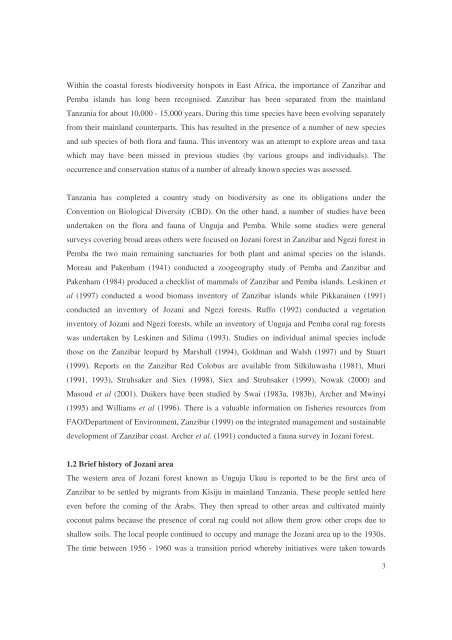Jozani biodiversity inventory report 2002 - Coastal Forests of Kenya ...
Jozani biodiversity inventory report 2002 - Coastal Forests of Kenya ...
Jozani biodiversity inventory report 2002 - Coastal Forests of Kenya ...
Create successful ePaper yourself
Turn your PDF publications into a flip-book with our unique Google optimized e-Paper software.
Within the coastal forests <strong>biodiversity</strong> hotspots in East Africa, the importance <strong>of</strong> Zanzibar and<br />
Pemba islands has long been recognised. Zanzibar has been separated from the mainland<br />
Tanzania for about 10,000 - 15,000 years. During this time species have been evolving separately<br />
from their mainland counterparts. This has resulted in the presence <strong>of</strong> a number <strong>of</strong> new species<br />
and sub species <strong>of</strong> both flora and fauna. This <strong>inventory</strong> was an attempt to explore areas and taxa<br />
which may have been missed in previous studies (by various groups and individuals). The<br />
occurrence and conservation status <strong>of</strong> a number <strong>of</strong> already known species was assessed.<br />
Tanzania has completed a country study on <strong>biodiversity</strong> as one its obligations under the<br />
Convention on Biological Diversity (CBD). On the other hand, a number <strong>of</strong> studies have been<br />
undertaken on the flora and fauna <strong>of</strong> Unguja and Pemba. While some studies were general<br />
surveys covering broad areas others were focused on <strong>Jozani</strong> forest in Zanzibar and Ngezi forest in<br />
Pemba the two main remaining sanctuaries for both plant and animal species on the islands.<br />
Moreau and Pakenham (1941) conducted a zoogeography study <strong>of</strong> Pemba and Zanzibar and<br />
Pakenham (1984) produced a checklist <strong>of</strong> mammals <strong>of</strong> Zanzibar and Pemba islands. Leskinen et<br />
al (1997) conducted a wood biomass <strong>inventory</strong> <strong>of</strong> Zanzibar islands while Pikkarainen (1991)<br />
conducted an <strong>inventory</strong> <strong>of</strong> <strong>Jozani</strong> and Ngezi forests. Ruffo (1992) conducted a vegetation<br />
<strong>inventory</strong> <strong>of</strong> <strong>Jozani</strong> and Ngezi forests, while an <strong>inventory</strong> <strong>of</strong> Unguja and Pemba coral rag forests<br />
was undertaken by Leskinen and Silima (1993). Studies on individual animal species include<br />
those on the Zanzibar leopard by Marshall (1994), Goldman and Walsh (1997) and by Stuart<br />
(1999). Reports on the Zanzibar Red Colobus are available from Silkiluwasha (1981), Mturi<br />
(1991, 1993), Struhsaker and Siex (1998), Siex and Struhsaker (1999), Nowak (2000) and<br />
Masoud et al (2001). Duikers have been studied by Swai (1983a, 1983b), Archer and Mwinyi<br />
(1995) and Williams et al (1996). There is a valuable information on fisheries resources from<br />
FAO/Department <strong>of</strong> Environment, Zanzibar (1999) on the integrated management and sustainable<br />
development <strong>of</strong> Zanzibar coast. Archer et al. (1991) conducted a fauna survey in <strong>Jozani</strong> forest.<br />
1.2 Brief history <strong>of</strong> <strong>Jozani</strong> area<br />
The western area <strong>of</strong> <strong>Jozani</strong> forest known as Unguja Ukuu is <strong>report</strong>ed to be the first area <strong>of</strong><br />
Zanzibar to be settled by migrants from Kisiju in mainland Tanzania. These people settled here<br />
even before the coming <strong>of</strong> the Arabs. They then spread to other areas and cultivated mainly<br />
coconut palms because the presence <strong>of</strong> coral rag could not allow them grow other crops due to<br />
shallow soils. The local people continued to occupy and manage the <strong>Jozani</strong> area up to the 1930s.<br />
The time between 1956 - 1960 was a transition period whereby initiatives were taken towards<br />
3
















